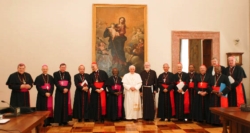From Cardinal Seán’s blog
Meeting with the Holy Father on the Tridentine Mass
From Cleveland I flew to Rome at the request of Cardinal Tarcisio Bertone to participate in a meeting discussing the Holy Father’s Motu Proprio about the use of the older form of the Latin Mass. There were about 25 bishops there, including the president of Ecclesia Dei Cardinal Dario Castrillon Hoyos, the prefect of Divine Worship and the Discipline of the Sacraments Cardinal Francis Arinze, several heads of bishops’ conferences as well as some cardinals and other residential bishops.
They shared with us the Motu Proprio and the Holy Father’s letter explaining it. We also had an opportunity to read the Latin document. We each commented on that, and then the Holy Father came in and shared some of his thoughts with us. The Holy Father is obviously most concerned about trying to bring about reconciliation in the Church. There are about 600,000 Catholics who are participating in the liturgies of the Society of St. Pius X, along with about 400 priests.
The Holy Father was very clear that the ordinary form of celebrating the Mass will be the new rite, the Norvus Ordo. But by making the Latin Mass more available, the Holy Father is hoping to convince those disaffected Catholics that it is time for them to return to full union with the Catholic Church.
So the Holy Father’s motivation for this decision is pastoral. He does not want this to be seen as establishing two different Roman Rites, but rather one Roman Rite celebrated with different forms. The Motu Propio is his latest attempt at reconciliation.
In my comments at the meeting I told my brother bishops that in the United States the number of people who participate in the Latin Mass even with permission is very low. Additionally, according to the research that I did, there are only 18 priories of the Society of St. Pius X in the entire country. Therefore this document will not result in a great deal of change for the Catholics in the U.S. Indeed, interest in the Latin Mass is particularly low here in New England.
In our archdiocese, the permission to celebrate the Latin Mass has been in place for several years, and I granted permission when I was in Fall River for a Mass down on the Cape. The archdiocesan Mass is now at Immaculate Mary of Lourdes Parish in Newton. It is well attended, and if the need arises for an extension of that we would, of course, address it.
This issue of the Latin Mass is not urgent for our country, however I think they wanted us to be part of the conversation so that we would be able to understand what the situation is in countries where the numbers are very significant. For example, in Brazil there is an entire diocese of 30,000 people that has already been reconciled to the Church.
General audience vespers
for the feast of Sts. Peter
and Paul
On Wednesday I had the opportunity to attend the weekly audience with the Holy Father.
At his Wednesday audiences, the Holy Father has been giving reflections on different fathers of the Church. This past Wednesday he reflected on St. Cyril of Jerusalem, a fourth-century bishop.
On Thursday evening, the vespers were offered in preparation for the feast of Sts. Peter and Paul.
Rome is what it is because it is the city sanctified by the martyrs Peter and Paul. These two men were chosen by the Lord for a very special mission in the history of salvation. Certainly St. Paul being the apostle of the gentiles, the author of so many epistles and the one who established the Church in so many different parts of the world beyond the Holy Land is a very, very significant figure. Additionally, his epistles are read each day at Mass, and his theology is so important for an understanding of the meaning of the Gospels.
Usually the vespers are held at the Basilica of St. Peter, but on Thursday the Holy Father held it at the tomb of St. Paul. There he declared a Pauline year in preparation of the synod on the holy Scriptures. This Pauline year will underscore the importance of Paul for Catholics throughout the world. It will also raise people’s awareness of the upcoming synod.
Also in this post:
> Visiting the Poor Clare Sisters of Cleveland



















